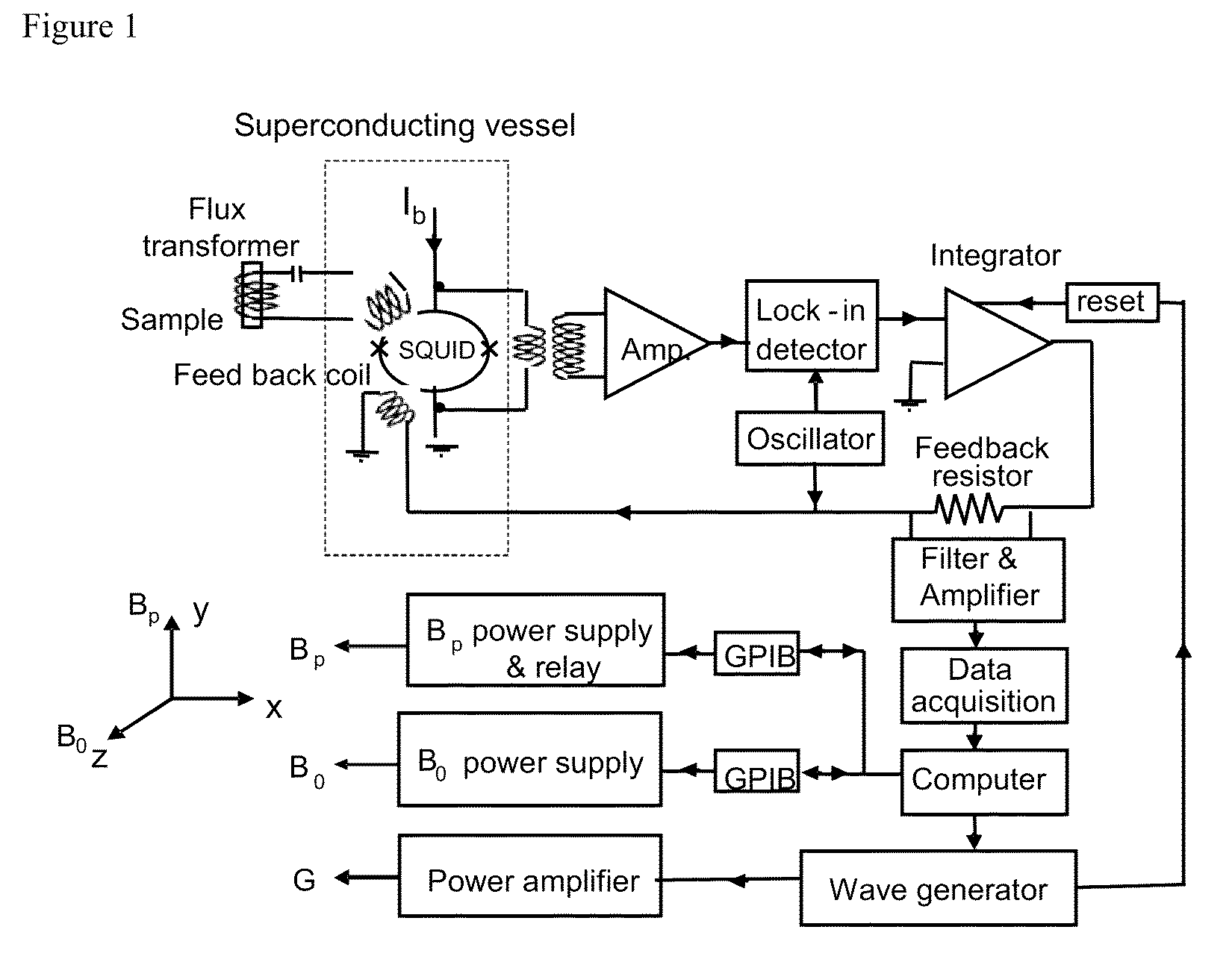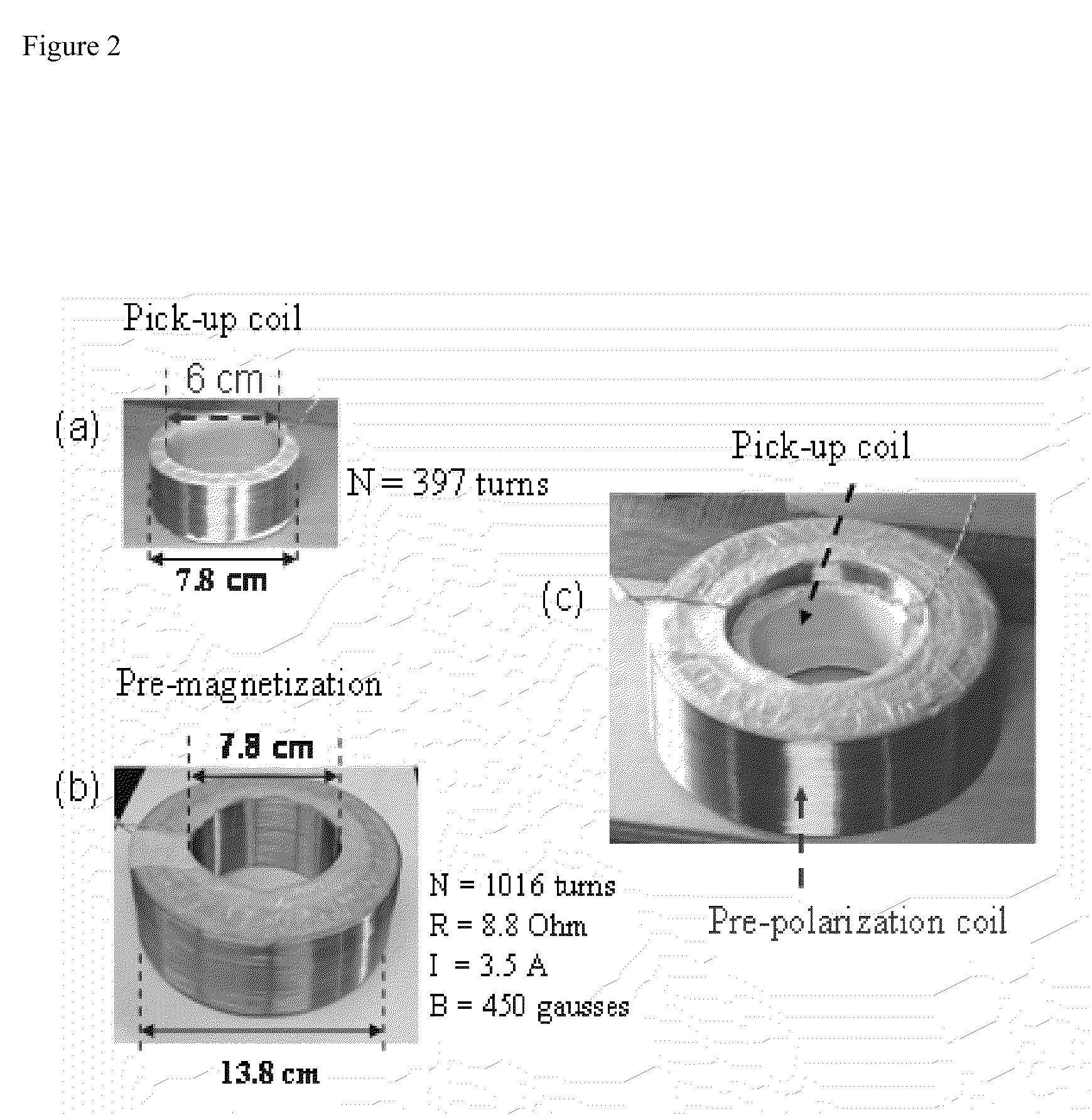Squid detected nuclear magnetic resonance and imaging at ultra-weak fields
a nuclear magnetic resonance and ultra-weak field technology, applied in the field of nuclear magnetic resonance and magnetic resonance imaging at ultra-low magnetic field, can solve the problems of affecting the squid, the effect of avoiding the sample from being too clos
- Summary
- Abstract
- Description
- Claims
- Application Information
AI Technical Summary
Benefits of technology
Problems solved by technology
Method used
Image
Examples
example 1
Experimental Apparatus for NMR / MRI
[0038]As FIG. 1 showed, the high-Tc SQUID-based NMR / MRI detection system was set up in an electromagnetically shielded room. The procession spin was inductively coupled to the SQUID magnetometer via a flux transformer consisting of a pickup coil and an input coil connected to a capacitor and an inductance to form a NMR resonance circuit. Besides, both the SQUID and the input coil were installed inside a superconducting Bi2Sr2Ca2Cu3Oy vessel which not only shielded environmental noises but also set the SQUID in a more stable operation condition.
[0039]FIG. 2 showed a photograph of the pre-polarization coil, the pickup coil and the unit which the pickup coil was fitted into the pre-polarization coil of the NMR detecting system. The pre-polarization coil was 1016 turns of wound copper coil capable of generating a pre-magnetic field of 450 gausses. The pickup coil composed of 397 turns of coils, in which the samples were placed, had an inner diameter of ...
example 2
Microtesla Field NMR
[0041]FIG. 4 showed the sequence used in NMR / MRI measurements. The static measuring field B0 of 101 μT was active along the z-axis direction, which was parallel to the plane of the SQUID magnetometer. A pre-polarization field Bp of 45 mT was applied along the y-axis, which was parallel to the plane of the SQUID magnetometer. Since the strength of the pre-polarization field was much larger than that of the static measuring field, the direction of nuclear spin magnetization of proton was then approximately aligned along y-axis. After applying a polarization field for a short time of Tbp, the pre-polarization field was switched of in 3 milliseconds. The nuclear magnetization processed along the direction of the measuring field B0. The gradient coils, which produced a gradient field of 24.6 μT / m for MRI, were constructed along the x-, y-, and z-directions. The MRI was taken using the back projection method with the applied gradient field rotated 15° for each imaging ...
example 3
NMR / MRI Experiments
[0042]FIG. 5 showed a typical NMR signal and it's Fourier transformer for 10 ml of pure water. The SNR is 45 and the line width was 0.9 Hz, which was measured at 101 μT and a field of 1 part in 5×103 in one shot.
[0043]FIG. 6 showed the MRIs after 70 averages for a ring-shaped phantom and a rectangular-shaped phantom. Both phantoms were filled with 10 ml of water. The ring-shaped phantom had an inner diameter of 24 cm and an outer diameter of 36 mm, whereas the rectangular-shaped phantom had a width of 28 mm at each side. The image was taken with a gradient field of 24.6 μT / m along the direction using the back projection technique. The filter back projection MRIs showed a clear image contrast. The dash line marked in the image was the geometry of phantoms under investigation.
[0044]FIG. 7 showed two cylindrical ring phantoms separated by a distance of 3 mm. Each ring phantom had an inner diameter of 12 mm, and outer diameter 24 mm and a height of 2.2 mm and containe...
PUM
 Login to View More
Login to View More Abstract
Description
Claims
Application Information
 Login to View More
Login to View More - R&D
- Intellectual Property
- Life Sciences
- Materials
- Tech Scout
- Unparalleled Data Quality
- Higher Quality Content
- 60% Fewer Hallucinations
Browse by: Latest US Patents, China's latest patents, Technical Efficacy Thesaurus, Application Domain, Technology Topic, Popular Technical Reports.
© 2025 PatSnap. All rights reserved.Legal|Privacy policy|Modern Slavery Act Transparency Statement|Sitemap|About US| Contact US: help@patsnap.com



